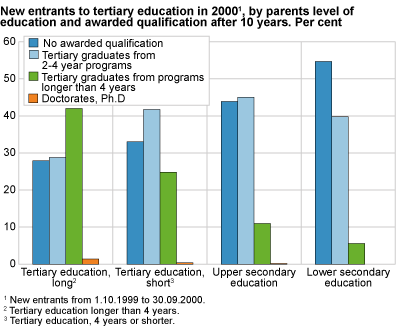Content
Published:
This is an archived release.
Two fifths of students do not finish degree
More and more students are not completing their degrees where the highest proportion is found among students whose parents have less than upper secondary education.
Among the about 40 100 new students who enrolled in tertiary education in autumn 2000, 41 per cent had not completed their degree after 10 years. This is an increase of 6 percentage points compared to the students who enrolled in tertiary education 10 years earlier. Men are still in majority with regard to not completing a degree. In the 2000 cohort, almost half of the male students did not complete a degree within 10 years. The corresponding share for women was nearly 36 per cent.
Parents' education counts
There are some disparities in completing tertiary education depending on the parents’ level of education. Among the new students in 2000 where one of the parents had a long tertiary education, about 72 per cent had completed tertiary education within 10 years. In comparison, approximately 45 per cent of the students whose parents had lower secondary education completed their tertiary education.
The largest difference is among tertiary graduates on programmes lasting more than four years. Forty-two per cent of the students whose parents had a long tertiary education completed a tertiary degree programme lasting more than four years. The corresponding share for students whose parents had lower secondary education was nearly 6 per cent.
Nearly a quarter of all bachelor students drop out
About 30 600 students enrolled on a bachelor’s degree programme for the first time in 2006, and 45 per cent of these completed their studies within three years. After a further two years, 62 per cent had completed their degree. Compared to the students who enrolled in 2005, the share that completed within five years increased by four percentage points. Twenty-three per cent of the students dropped out within the five-year period, and nine per cent within the first year.
More engineer students complete
In autumn 2006, almost 2 800 students enrolled in the engineering foundation programme for the first time. Fifty-five per cent completed within three years. After a further two years, 65 per cent had completed their education. The share of students who completed within three years increased by seven percentage points compared to the students who enrolled in 2005. One out of five dropped out during the five-year period.
Completion timeCompletion time is defined as the number of years since initial registration in tertiary education, and no readjustment is made if a student changes to a new degree. According to this definition, very few students who switch degrees during their study period will be able to finish within the expected timeframe. Deferment and part-time studying are not accounted for either. In tables showing students enrolled in specific courses in tertiary education, completion time is defined as the number of years since initial registration in that specific programme. |
Tables:
- Table 1 Undergraduate courses, by number of graduates in 2010/2011 since the student was first registered in tertiary education, by gender and duration of study. Absolute figures and per cent
- Table 2 Postgraduate courses, by number of graduates in 2010/2011 since the student was first registered in tertiary education, by gender and duration of study. Absolute figures and per cent
- Table 3 New entrants to tertiary education in 1990 and 2000, by gender and awarded qualification after ten years. Absolute figures and per cent
- Table 4 New entrants to tertiary education in 1990 og 2000, by parents' level of education and awarded qualification after 10 years. Absolute figures and per cent
- Table 5 Students who enrolled in a bachelor´s degree programme for the first time in 2006, and awarded qualifications at 1 october 2011, by gender and completed course of study
- Table 6 Students who enrolled in nursing, foundation programme for the first time 2006, and awarded qualifications at 1 october 2011, by gender and parents´ level of education
- Table 7 Students who enrolled in pre-school teacher, foundation programme for the first time 2006, and awarded qualifications at 1 october 2011, by gender and parents´ level of education
- Table 8 Students who enrolled in engineering, foundation programme for the first time 2006, and awarded qualifications at 1 october 2011, by gender and parents´ level og education
- Table 9 Students who enrolled in general teacher training programme for the first time in 2005, and awarded qualifications at 1 october 2011, by gender, educational institution and parents´ level of education
- Table 10 Students who enrolled in master of odontology for the first time 2004, and awarded qualifications at 1 october 2011, by gender
- Table 11 Students who enrolled in cand.med. for the first time 2003, and awarded qualifications at 1 october 2011, by gender
Contact
-
Jane Bekkengen
E-mail: jane.hansine.bekkengen@ssb.no
tel.: (+47) 40 81 13 52
-
Geir Nygård
E-mail: geir.nygard@ssb.no
tel.: (+47) 48 15 13 44
-
Nawid Fazli
E-mail: nawid.fazli@ssb.no
tel.: (+47) 97 09 77 18

